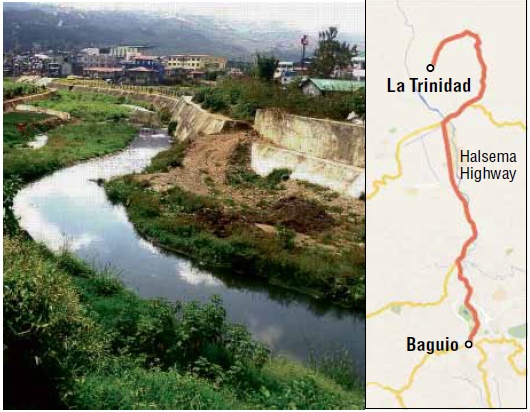Baguio-La Trinidad traffic solvers hope for e-trains

E-TRAIN PROJECT Baguio City and neighboring La Trinidad town in Benguet province (inset: map) are looking at a proposal to revitalize the Balili River as host of the elevated tracks of electricity-run trains. PHOTO COURTESY OF LA TRINIDAD GOVERNMENT/INQGRAPHIC BY ELIZALDE PUSUNG
BAGUIO CITY—Elevated trains, powered by electricity, that will link this city to the town center and strawberry farms of neighboring La Trinidad in Benguet province, are fast becoming a popular option for mass transport to ease traffic and reduce air pollution in these urban communities.
The Filipino-designed Automated Guideway Transit (AGT) was suggested by the Department of Science and Technology (DOST) to the local governments of La Trinidad and Baguio as early as two years ago. The proposed 5.2-kilometer railway can ferry 720 passengers in six coaches.
The P1.2-billion AGT railway will cut down to 15 minutes the almost hour-long travel from Baguio’s Magsaysay Avenue or Bokawkan Road through the only road leading to the La Trinidad town center during rush hour, said Julius Sicat, DOST Cordillera director.
Based on its initial design, the railway will follow the Balili River, which connects La Trinidad and Baguio, to reach the Benguet capitol grounds.
La Trinidad hosts the vegetable trading post, which draws trucks that deliver and haul produce every day. It also serves as a gateway to Mountain Province and other Cordillera provinces.
During the Balili River Day celebration held in Baguio on Wednesday, a team of engineers from the Department of Public Works and Highways calculated that flood levels from the river could rise by 2 to 3 meters in the next 25 years.
“The AGT must take those latest findings when it designs the train through La Trinidad,” said Benedict Pineda, La Trinidad environment officer.
On Monday, economists from the University of the Philippines (UP) endorsed a separate AGT track running through downtown Baguio to replace diesel-run jeepneys, which have been blamed for high concentrations of air pollutants in the city.
Achilles Costales, a UP Baguio economics professor, and Maria Angeles Catelo, an economist from UP Los Baños, said jeepneys had contributed to the pollution level in the central business district, which has risen to 83 micrograms per cubic meter of finer particulates (PM10). This figure is the five-year average computed from 2007 to 2012 by the Environmental Management Bureau.
Costales and Catelo presented a paper that computed the monetary value of ailments directly attributed to concentrated exposures from air pollution in downtown Baguio. They said a seven-minute reduction in travel time to downtown amounts to a savings of P98.3 million in opportunity costs.
La Trinidad has similar problems with pollution. In 2012, the EMB reported that the ambient air quality in the town was classified as “unhealthy” due to high concentrations of PM10.
“The main generators of PM10 in the [Baguio] central business district have been traced to the diesel engines [of] transport vehicles plying [its] road network,” the report said.
The UP economists said they conducted a cost-benefit analysis of the AGT as a replacement for over 2,600 jeepneys plying downtown Baguio.
They said the system will require a P280-million investment to build a 4-km elevated track encircling the downtown area and university belt, a P450-million investment to buy a fleet of 30 coaches, P28 million to build a depot, and P20 million to build 20 train stations.
The investor will also spend P67 million in electricity consumed to power the trains.
Social benefits from the AGT would be an estimated savings of P77 million that pays for medical treatments of respiratory infected patients or the income loss from their caregivers. The project stands to earn P319 million annually for serving as many as 73,600 passengers daily.
Earlier, the Baguio Heritage Foundation endorsed a sustainable urban mobility plan, which would reroute jeepneys from Session Road to help clean the air. The plan also proposes to ban vehicles on Session Road, keeping it open as a “pedestrian mall.” With a report from Kimberlie Quitasol, Inquirer Northern Luzon